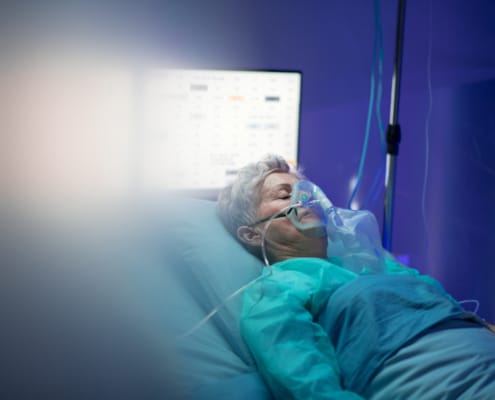How ICU Telehealth Addresses The Burden of Acute Respiratory Failure

ICU Telehealth: Virtual Emergency Care from Intercept Telehealth
ICU Telehealth services are well positioned to provide solutions for the increasing costs and complications tied to the growing medical problem of Acute Respiratory Failure (ARF) across the United States. Telemed services such as virtual emergency care speak directly to the challenges faced by patients and healthcare professionals alike. ICU care monitoring works to ensure that the treatment of ARF is always completed correctly and without complications that can cause a patient harm or create extensive financial burdens. When hospitals or healthcare facilities simply do not have the skilled talent on-hand to properly care for patients experiencing ARF, ICU patient monitoring systems aid workforces and ensure that they can provide the best and most efficient care possible. By connecting with qualified and skilled talent remotely, hospital and healthcare facility workflows become more efficient while the quality of care they provide is held to the highest standard, regardless of location or ongoing labor shortages.
Tele ICU provider, Intercept Telehealth is your partner in addressing many of the costly and complex issues of ARF and its related conditions. Take strides to ensure ongoing and optimal efficiency within your hospital, from initial patient administration to final discharge. Tap into skilled talent including respiratory specialists who can ensure your staff can correctly care for those experiencing ARF.
ICU Telehealth: Speaking To The Costs of Acute Respiratory Failure
Currently, the nature of ARF is costing hospitals and healthcare facilities in America over $27 billion1, with 2.5 million ICU admission per year2 and a staggering 30 percent mortality rate3. Adult Respiratory Distress Syndrome (ARDS), a subset of ARF, poses similar challenges and continues to trend in a troubling direction.
One 2021 study documented that a patient’s first admission for ARDS had an average cost of $107,866 to $157,800, with $42,574 of those costs being incurred during the first post-discharge year, and $62,465 after the next two years4-5. While these numbers may have been skewed by the COVID-19 pandemic, it is sufficient to say that it is a tremendous cost to healthcare facilities that are already working with strained budgets and a lack of specialized talent.
These challenges are especially prevalent in rural parts of America where specialized nurses and doctors are simply unavailable. Truthfully, the treatment of ARF is often suboptimal and is typically far more costly than it should be.
ICU Telehealth and The Misuse of Non-Invasive Positive Pressure Ventilation
Many times, before patients are intubated for respiratory failure, they may receive non-invasive positive pressure ventilation (NIPPV). NIPPV’s advantages include the avoidance of deep sedation/paralysis, reductions in ventilator-associated pneumonia, and lessened delirium. NIPPV can also be completed in step-down and medical-surgical units.
However, the truth is that NIPPV can also be misused and utilized incorrectly. NIPPV is often implemented at inappropriate times when patients should be immediately intubated, or patients are kept on it for too long to see if they “turn around” their condition. When NIPPV is prolonged inappropriately, patients suffer the most as they are twice as likely to have an adverse event such as aspiration, hypotension, or oxygen desaturation when intubated, and also have increased mortality odds.6
Worldwide, when patients are finally intubated, adherence to lung protective mechanical ventilation (tidal volumes of 6.5 mL/kg IBW and plateau pressure <= 30 cm H20), the gold standard treatment for ARDS treatment, is mixed.7 In 2016, 35% of patients received tidal volumes >= 8 mL/kg IBW, a tidal volume level that harms all patients on invasive mechanical ventilation, not just those with ARDS. A 2021 study during the COVID-19 pandemic did show an improvement in the adherence to this gold standard, but even so, less than half of COVID-19 patients with ARDS received a tidal volume <= 6.5 mL/kg IBW. This information is pulled from a highly resourced medical system, the University of Pennsylvania Health System8 and such numbers could be even worse in other healthcare settings that have little or no specialized staff and fewer resources.
ICU Telehealth Services from Intercept Telehealth
Healthcare facilities, including hospitals, can help staff adhere to the gold standard of treatment for ARDS. Consistent and sound treatment practices can help your facility provide quality care with Tele ICU ventilator rounds conducted in partnership with Intercept Telehealth. No matter the location or lack of skilled talent, Intercept Telehealth connects your workforce with specialized talent that can dictate and direct them toward the gold standard treatment of ARDS and ARF. When skilled talent is available remotely, see your low tidal volume adherence improve from 29.5 percent to 44.9 percent, ventilator duration decrease by over 15 percent and an ICU mortality ratio decrease from .94 to .67.9
REFERENCES
- Dasta JF, McLaughlin TP, Mody SH, et al.: Daily cost of an intensive care unit day: The contribution of mechanical ventilation. Crit Care Med 2005; 33:1266–1271.
- Dasta, et al.
- Wunsch H, Linde-Zwirble WT, Angus DC, et al.: The epidemiology of mechanical ventilation use in the United States. Crit Care Med 2010; 38:1947–1953.
- Clermont G, Kong L, Weissfeld LA, et al. The effect of pulmonary artery catheter use on costs and long-term outcomes of acute lung injury. PLoS One. 2011;6(7): e22512.
- Ruhl AP, Lord RK, Panek JA, et al. Health care resource use and costs of two-year survivors of acute lung injury: an observational cohort study. Ann Am Thorac Soc. 2015;12(3):392-401.
- Mosier, J.M., Sakles, J.C., Whitmore, S.P. et al. Failed noninvasive positive-pressure ventilation is associated with an increased risk of intubation-related complications. Ann. Intensive Care 5, 4 (2015). https://doi.org/10.1186/s13613-015-0044-1.
- Bellani G, Laffey JG, Pham T, et al. Epidemiology, Patterns of Care, and Mortality for Patients With Acute Respiratory Distress Syndrome in Intensive Care Units in 50 Countries. JAMA. 2016;315(8):788–800. doi:10.1001/jama.2016.0291.
- Levy, Elizabeth MD1; Scott, Stefania MS2; Tran, Teresa MPH2; Wang, Wei PhD2; Mikkelsen, Mark E. MD, MSCE1–3; Fuchs, Barry D. MD1,3; Kerlin, Meeta Prasad MD, MSCE1–3. Adherence to Lung Protective Ventilation in Patients With Coronavirus Disease 2019. Critical Care Explorations 3(8):p e0512, August 2021. | DOI: 10.1097/CCE.0000000000000512.
Kalb, T., Raikhelkar, J., Meyer, S., Ntimba, F., Thuli, J., Gorman, M. J., Kopec, I., & Scurlock, C. (2014). A multicenter population-based effectiveness study of teleintensive care unit-directed ventilator rounds demonstrating improved adherence to a protective lung strategy, decreased ventilator duration, and decreased intensive care unit mortality. Journal of critical care, 29(4), . https://doi.org/10.1016/j.jcrc.2014.02.017



